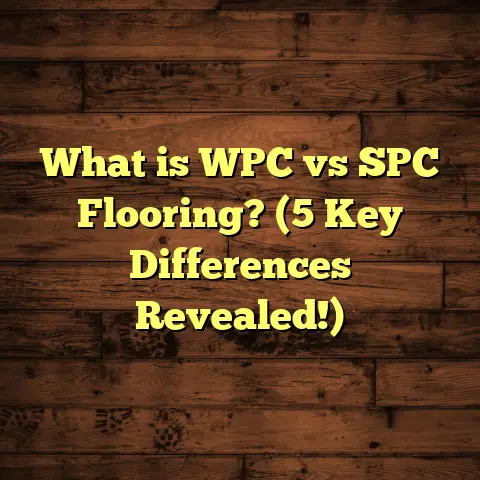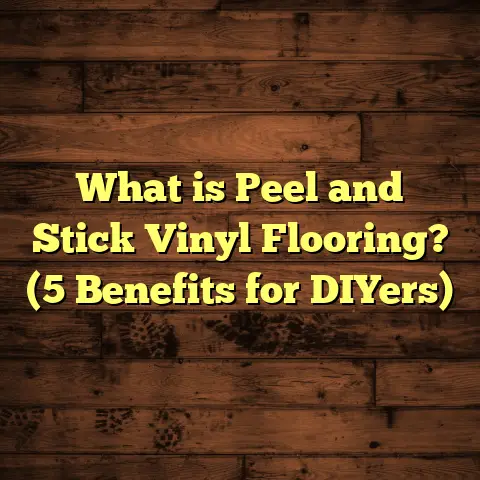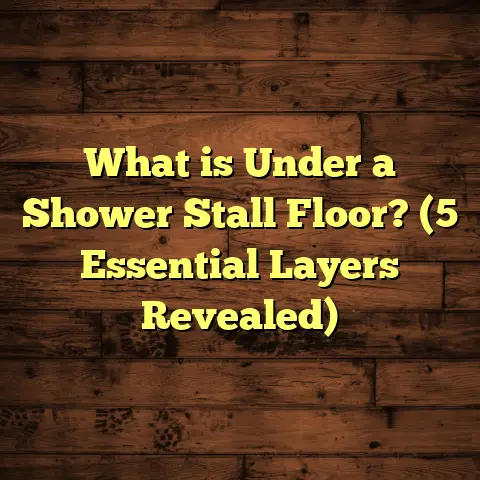What is Floating Cork Flooring? (5 Benefits for Your Home)
Floating Cork Flooring: 5 Benefits for Your Home
I’m going to be upfront with you: if you haven’t considered floating cork flooring
for your home yet, you’re missing out on something pretty amazing. I’ve been in
the flooring business for over a decade, and floating cork floors have stood out
to me as one of the most versatile, eco-friendly, and comfortable options available.
Let me share what I’ve learned, some stories from the field, and why this might be
the perfect choice for your floors.
What Is Floating Cork Flooring?
Floating cork flooring is a type of floor installation where the cork planks or tiles
are not glued or nailed down directly to the subfloor. Instead, these boards “float”
on top of an underlayment, locking together with a tongue-and-groove system. This
method creates a cushioned, resilient surface that’s both functional and stylish.
Cork itself is harvested from the bark of cork oak trees, which regrows every 9-12
years without harming the tree. This makes cork flooring a sustainable material, plus
it has natural properties that make it stand out. The floating installation allows
for easy DIY setups and can be placed over many existing surfaces like concrete or wood.
Let me tell you: switching to floating cork flooring was a game-changer for one of
my clients who wanted something warm but also eco-friendly. They loved how quickly
we installed it and how comfortable it felt underfoot.
A Closer Look at Cork as a Material
Before we get into why floating cork flooring works so well, I want to talk about
cork itself. It’s not just some random material plucked from a tree—it’s an incredible
natural product with unique features that make it perfect for floors.
What Makes Cork Special?
Cork is made up of millions of tiny air-filled cells. Think of it like a natural sponge,
but much tougher. These cells trap air, making cork lightweight, compressible, and highly
insulative. This cellular structure is what gives cork flooring its softness and warmth.
Unlike many synthetic materials, cork is also hypoallergenic and resistant to dust mites,
which is great news if anyone in your home suffers from allergies or asthma.
How Does Cork Compare to Other Flooring Materials?
I often get asked how cork stacks up against hardwoods, laminates, or vinyl. Here’s what I tell people:
- Hardwood: Beautiful and long-lasting but can feel cold and hard underfoot. Also prone to dents and scratches.
- Laminate: Affordable and easy to install but not as comfortable or eco-friendly.
- Vinyl: Water-resistant and durable but made from PVC plastic which isn’t biodegradable.
- Cork: Combines softness with durability and is renewable. It’s also quieter than hardwood or laminate.
If you want a floor that feels good on your feet but lasts long enough for everyday life, cork is definitely worth considering.
Why Floating Cork Flooring Works So Well: 5 Key Benefits
Now let’s talk about those benefits I promised. Floating cork flooring offers several clear advantages that make it stand out from other flooring options.
1. Comfort and Warmth Underfoot
Have you ever walked barefoot on tile or hardwood and felt that cold, hard surface?
That’s something I often hear from homeowners looking for a softer feel.
Cork is naturally soft and springy because it contains air-filled cells making it feel warm and cushioned underfoot. According to some studies, cork flooring can reduce foot pressure by up to 30% compared to hardwood floors. This means less fatigue when standing or walking for long periods.
I remember installing floating cork in a family’s kitchen where mom stood cooking for hours daily. She told me the difference was night and day—less strain on her feet and back. It’s no wonder cork floors are popular in places where you spend a lot of time standing.
The Science Behind Comfort
What makes cork so comfortable? It’s all about shock absorption. The elasticity in cork allows it to compress slightly under pressure and then bounce back. This reduces strain on joints and muscles.
For people with arthritis or plantar fasciitis, this small difference can translate into big comfort gains.
2. Eco-Friendly and Renewable
One of the things I deeply appreciate about cork flooring is its sustainability. The bark harvesting process doesn’t kill the cork oak tree; it actually encourages new growth. This renewable cycle repeats every decade or so, making cork one of the most environmentally responsible flooring materials available.
In my experience, more homeowners are asking about eco-friendly options, wanting to reduce their carbon footprint without sacrificing style or quality. Cork fits perfectly into that mindset.
To give you some numbers: cork forests absorb an estimated 5 million tons of CO2 each year in Portugal alone—the world’s largest cork producer. Choosing cork flooring is a way to support this environmental balance while enjoying a beautiful home finish.
Environmental Impact Compared to Other Floors
Here’s something interesting: producing one square meter of cork flooring generates far fewer greenhouse gases than producing hardwood or vinyl flooring.
Vinyl production alone emits significant amounts of volatile organic compounds (VOCs), which can negatively affect indoor air quality.
Cork’s natural harvesting process also contributes to biodiversity by supporting the ecosystem around cork oak forests.
If you care about reducing your home’s environmental impact, floating cork floors are a solid choice.
3. Sound Insulation and Noise Reduction
Have you ever lived in an apartment with noisy neighbors or hardwood floors that echo every step? Cork floors provide an excellent sound barrier because of their cellular structure filled with air pockets.
Floating cork flooring adds an extra layer of noise insulation since it isn’t fixed directly to the subfloor but “floats” on top. This means it absorbs sound vibrations better than many other materials.
From what I’ve seen working on multi-family housing projects, tenants often note how much quieter their spaces feel after we install cork floors. It’s a huge bonus if you live in a busy household or want to keep things peaceful.
How Does Sound Travel Through Floors?
Sound travels by vibrations through solid materials like wood or tile. Since cork absorbs these vibrations instead of transmitting them, it helps reduce noise between floors.
In fact, testing shows that cork floors can reduce impact noise by as much as 20 decibels compared to hardwood floors.
If you live in an apartment or have kids running around upstairs, this benefit alone can improve your quality of life immensely.
4. Durability and Easy Maintenance
You might think cork is delicate because it’s soft, but it’s surprisingly durable if treated right. Thanks to modern finishes like polyurethane coatings, floating cork floors resist scratches, stains, and wear well.
I’ve had customers with kids and pets report their cork floors holding up beautifully over years, even in high-traffic areas. Plus, cork’s natural resistance to mold and mildew makes it great for moisture-prone rooms.
Maintenance is straightforward: regular sweeping or vacuuming combined with occasional damp mopping keeps the floor looking fresh. Avoid soaking it with water, as excessive moisture can damage any floating floor system.
How Long Do Cork Floors Last?
While some people worry floating floors won’t last as long as glued-down ones, I have seen properly installed floating cork floors last 15-20 years or more with routine care.
The key is protecting the surface finish by avoiding sharp objects or heavy dragging furniture without pads.
5. Easy Installation and Cost Efficiency
Here’s something I’ve learned firsthand: floating cork flooring is one of the easier floors to install yourself—or with minimal help from pros.
Because it doesn’t require glue or nails to attach to the subfloor, installation times shrink dramatically. You just snap the planks together over an underlayment that protects against moisture and smooths out imperfections.
This floating design also means fewer prep costs since you don’t need to level or prime the subfloor as extensively as with glued-down options.
I use FloorTally regularly to help me estimate costs for projects involving floating cork floors. It factors in local labor rates, materials, waste allowance, and more—which saves me so much time balancing budgets versus quality choices. If budgeting stresses you out like it used to me, this kind of tool can make your life easier.
DIY or Hire a Pro?
If you’re handy with tools and have patience, floating cork installation can be a weekend project for most rooms under 500 square feet.
For larger jobs or complex layouts (like stairs or uneven subfloors), I usually recommend hiring a pro but even then installation tends to be quicker than traditional glue-down floors.
My Personal Stories With Floating Cork Floors
I want to share a couple real situations where floating cork really made a difference for my clients—and why I keep recommending it even years later.
Family Kitchen Transformation
I mentioned earlier about installing floating cork in a client’s kitchen—let me expand on that story because it highlights several benefits all at once.
The family had two young kids and cooked daily meals for their large household. Their hardwood floor was cold in winter and kids complained about slips after spills despite rugs everywhere.
We chose floating cork with an extra thick underlayment for comfort and safety. The installation took two days total—less than half the time we expected—and mom immediately noticed the warmth underfoot when cooking breakfast early mornings.
A year later they told me:
- No more cold feet on winter mornings
- Easier cleanup after spills (cork resists stains well)
- Reduced noise from running kids upstairs
- Noticeably less foot and back fatigue during cooking marathons
For them, floating cork wasn’t just a floor upgrade; it changed how they experienced their kitchen daily.
Condo Noise Nightmare Solved
Another memorable project was in a small downtown condo building where tenants complained about loud footsteps from neighbors above them.
We installed floating cork over their existing laminate floors in all units on one floor as part of renovation efforts. The feedback was immediate—noise complaints dropped sharply because the floor absorbed much more impact sound than before.
Residents said conversations felt clearer without background thuds from above interfering.
That project showed me how floating cork can improve living comfort beyond looks or feel—actually making homes quieter and more pleasant places to be.
Installation Tips From My Experience
Installing floating cork flooring isn’t rocket science but there are a few things I always stress with clients:
- Choose quality underlayment: The right underlayment improves comfort and sound dampening while protecting your floor from moisture damage.
- Acclimate your cork planks: Let the flooring sit in your home environment for at least 48 hours before installation to avoid expansion or contraction issues later.
- Check your subfloor: Uneven surfaces can cause problems down the line; make sure your subfloor is flat within tolerance limits before installing.
- Use furniture pads: Even though cork is durable, placing felt pads under furniture legs prevents dents or scratches.
- Keep humidity stable: Cork responds to humidity changes by expanding or contracting slightly — try to maintain indoor humidity between 30-50% for best results.
- Clean gently: Avoid harsh chemicals; mild soap with water works best.
- Leave expansion gaps: Don’t forget to leave gaps around room edges so the floor can expand without buckling.
Following these tips saves headaches later on maintenance or repairs—and keeps your floor looking great for years.
Floating Cork Flooring Cost Breakdown
Talking about costs is important because budgets can make or break decisions when choosing new floors.
Material Costs
Floating cork planks typically range from $4-$8 per square foot based on thickness, finish quality, and brand reputation. Premium collections with decorative patterns or enhanced durability may cost more.
If you want something budget-friendly but still good quality, look around for mid-range options priced near $5-$6 per square foot—that’s what I often recommend for most homes balancing price vs longevity.
Installation Costs
Professional installation usually adds $2-$5 per square foot depending on labor rates in your area and job complexity (stairs cost more).
DIY installation cuts these labor costs entirely but requires time and some skill with tools like spacers, saws, tapping blocks, etc.
Waste Factor
Don’t forget waste allowance! Plan for roughly 5-10% extra material because cutting pieces means leftover scraps you can’t use elsewhere.
This waste factor is automatically included when I run estimates through FloorTally—it helps me avoid costly surprises later on orders.
What About Underlayment?
Underlayment prices vary widely—from $0.50 to $2 per square foot depending on soundproofing properties or moisture barriers needed underneath floating floors.
How FloorTally Helps Me With Flooring Projects
Since budgeting is often tricky—especially when balancing material quality against labor costs—I rely heavily on tools like FloorTally during project planning.
It lets me:
- Input project size precisely
- Select local labor rates based on ZIP code
- Choose specific materials (floating cork included)
- Automatically calculate waste allowance
- Visualize total project costs clearly
- Adjust variables quickly to fit client budgets
Using FloorTally saves me hours getting quotes from multiple suppliers or contractors manually—and helps clients see exactly where their money goes upfront instead of being surprised by last-minute expenses.
If you ever feel overwhelmed by estimating material needs or costs for flooring projects yourself, trying this tool might ease that headache like it did mine years ago when I started out in flooring sales.
Maintaining Your Floating Cork Floor: Tips That Work
Even though floating cork floors are durable and easy-care by nature, proper maintenance keeps them looking fresh longer:
- Sweep or vacuum weekly to remove dirt that could scratch surface
- Wipe spills immediately before they soak in
- Use damp mop sparingly with mild soap solution (avoid harsh cleaners)
- Place rugs at entryways to reduce tracked-in grit
- Reapply finish coatings every few years if wear appears (professionals usually do this)
- Avoid excessive water exposure—never steam mop these floors!
Following these simple steps extends life expectancy well beyond 15 years if cared for properly—which many customers appreciate after investing in quality flooring upfront instead of cheap alternatives needing replacement sooner.
What About Style? Floating Cork Flooring Looks Great Too
One thing I love sharing with clients is how versatile cork flooring styles have become recently.
No longer limited to just “plain brown,” modern floating cork comes in various colors, textures, patterns—even faux wood grain finishes that mimic hardwood but still offer all the benefits of natural cork underneath.
You can find:
- Light blond shades for bright airy spaces
- Rich dark browns adding warmth
- Grayish tones fitting modern minimalist homes
- Multi-tonal patterns creating visual interest without overwhelming rooms
If you want something eco-friendly but also stylish enough to impress guests (and yourself), floating cork delivers on both fronts beautifully.
FAQs About Floating Cork Flooring
Q: Can floating cork flooring be installed in bathrooms?
A: Typically no; since bathrooms have high moisture levels, floating floors risk water damage unless sealed very carefully. Glue-down vinyl tile might be better suited there instead.
Q: How thick should my floating cork planks be?
A: Thickness usually ranges from 6mm–12mm; thicker boards mean better comfort but cost more. Around 8–10mm works well balancing durability vs price for most homes.
Q: Will my furniture damage floating cork?
A: Not if you use felt pads under legs! Cork resists dents but sharp heavy furniture can cause indentations if dragged without protection.
Q: Is floating cork noisy when walked on?
A: No—actually it reduces noise compared to hardwood because its soft cellular structure absorbs impact sounds well.
Q: How do I fix scratches on my floating cork floor?
A: Minor scratches can sometimes be buffed out gently; deeper gouges require refinishing or replacing damaged planks depending on severity.
Wrapping Up My Thoughts
Floating cork flooring is one of those rare options that offers comfort, style, environmental benefits, sound control—all wrapped up into an easy-to-install package that fits many budgets too.
After years of installing various kinds of floors—from tile kitchens to luxury wood halls—I keep coming back to recommending floating cork whenever clients want something unique yet practical with real value over time.
If you’re thinking about upgrading your home’s floors and haven’t tried floating cork yet… maybe now’s the time?
Got questions about your specific space? Wondering if floating cork fits your lifestyle? Just ask—I’m happy to share more tips or help figure out what works best for you!





